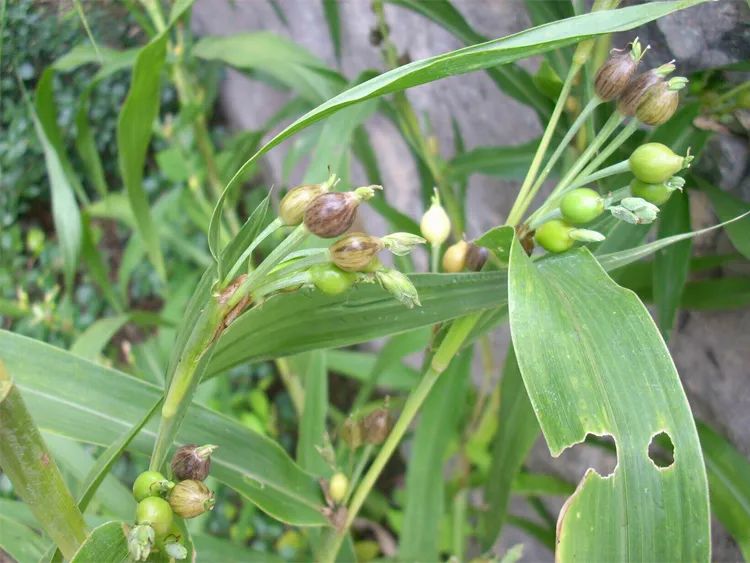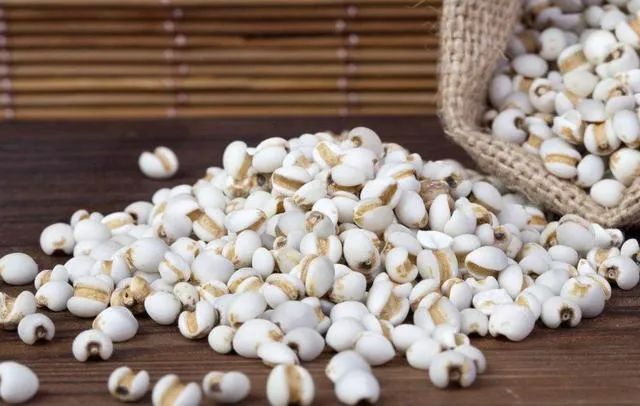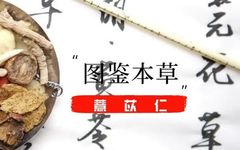
01 Plant Morphology

This is an annual or perennial herb. It grows in clumps and is highly branched. The leaves are alternate; the leaf blades are linear-lanceolate, smooth on both sides, with rough edges. The racemose inflorescence is axillary; the male spikelets are arranged in a whorled pattern on each node of the spike axis; the female spikelets are enclosed in an oval, hard glume, which is grayish-white or bluish-purple, hard and smooth, with a glossy surface. The flowers have three degenerated stamens; there is one pistil with a bifid stigma. The caryopsis is round and bead-like. The flowering period is from July to August, and the fruiting period is from September to October.
02 Properties of the Medicinal Material

This product is broad-oval or long-elliptical, measuring 4-8 mm in length and 3-6 mm in width. The surface is milky white and smooth, occasionally with remnants of yellow-brown seed coats. One end is bluntly rounded, while the other end is wider and slightly concave, with a light brown dotted hilum. The back is rounded and convex, and the ventral side has a wider and deeper longitudinal groove. The texture is solid, with a white cross-section that is powdery. The aroma is mild, and the taste is slightly sweet.
【Source】This product is the dried mature seeds of the plant Coix lacryma-jobi. The plants are harvested in autumn when the fruits are ripe, dried, and the fruits are threshed, then dried again, removing the outer shell, yellow-brown seed coat, and impurities to collect the seeds.
【Distribution】It grows by rivers, streams, or in damp valleys, preferring warm and humid areas. It is mainly produced in Guizhou and other regions.
【Harvesting and Processing】In autumn, when the fruits are ripe, the plants are harvested, dried, and the fruits are threshed, then dried again, removing the outer shell and seed coat.
【Nature and Taste】It is cool in nature, with a sweet and bland taste; it enters the Spleen (Pi) channel, Stomach (Wei) channel, and Lung (Fei) channel.
【Functions and Indications】It strengthens the Spleen, promotes diuresis, alleviates dampness, clears heat, and expels pus. It belongs to the category of diuretic and dampness-eliminating herbs.
【Dosage】The dosage is 10-30 grams. It can be decocted for internal use; or made into pills, powders, soaked in wine, cooked in porridge, or made into soups.
【Precautions】This product is mild in action and should be taken in larger quantities over a longer period. It should be used with caution in cases of Spleen deficiency without dampness, dry constipation, and in pregnant women.
03 Clinical Applications
1. For urinary difficulties, edema, beriberi, and damp-heat symptoms:
Yi Yi Ren functions to promote diuresis and eliminate dampness, with a relatively mild effect. However, due to its slightly cold nature, it can be used for symptoms of internal damp-heat, such as short and red urination, and can be combined with Hua Shi (Talcum) and Tong Cao (Rice Paper Plant); for damp-heat pathogens in the Qi level, with a predominance of dampness, it can be combined with Xing Ren (Apricot Kernel), Cao Ren (Cardamom), Zhu Ye (Bamboo Leaf), and Mu Tong (Akebia). This product also has the function of strengthening the Spleen, used to treat Spleen deficiency with edema and beriberi pain, often combined with Fu Ling (Poria), Bai Zhu (White Atractylodes), Mu Guo (Papaya), and Wu Zhu Yu (Evodia).
2. For diarrhea and leukorrhea:
This product can both strengthen the Spleen and eliminate dampness, thus suitable for diarrhea and leukorrhea due to Spleen deficiency with dampness, often combined with Bai Zhu (White Atractylodes) and Fu Ling (Poria).
3. For damp obstruction, pain, and muscle spasms:
This product can dispel dampness and relieve spasms, thus can be used for pain and spasms caused by damp obstruction in the skin and muscles, often combined with Gui Zhi (Cinnamon Twig) and Cang Zhu (Atractylodes).
4. For lung abscess and intestinal abscess:
Yi Yi Ren can clear lung heat and drain damp-heat from the intestines and stomach, often used for internal abscesses, with the function of expelling pus and resolving abscesses. For lung abscess with chest pain and purulent sputum, it can be combined with Xian Lu Gen (Fresh Reed Root), Dong Gua Zi (Winter Melon Seed), Tao Ren (Peach Kernel), and Yu Xing Cao (Houttuynia); for intestinal abscess, it can be combined with Bai Jiang Cao (Patrinia) and Fu Zi (Aconite).
Dr. Liu’s Premium Authentic Yi Yi Ren
When it comes to Yi Yi Ren, many people are familiar with it; Yi Yi Ren is what we commonly refer to as Job’s Tears. Job’s Tears is a relatively common Chinese medicine, known for its functions of strengthening the Spleen and benefiting the Stomach, nourishing the Lung and clearing heat, and dispelling wind and overcoming dampness. Additionally, in daily life, many people enjoy using it to make soups and desserts, as it has a sweet taste and is well-loved. However, many people are unsure how to select Yi Yi Ren when purchasing, often ending up with fake or mixed products. On the market, it is common for similar plants like Bai Gao Liang (Sorghum) to be sold as Yi Yi Ren. To ensure your health, it is important to know how to identify genuine Yi Yi Ren.
1. The simplest and most practical way to judge the quality of Job’s Tears is by its aroma. Just take a handful of Job’s Tears and smell it. Genuine Job’s Tears should have a pure rice fragrance, and the fresher the Job’s Tears, the stronger the aroma.
2. Take a grain of Job’s Tears and bite it; if it makes a cracking sound, it indicates that this Job’s Tears is not damp and is of good dryness.
3. Judging the quality of Job’s Tears by appearance, good Job’s Tears should be plump, shiny, and have a broad oval or long-elliptical shape, with a white or yellowish-white surface; one end should be bluntly rounded, while the other end should be wider and slightly concave, with a light brown dotted hilum. The back should be rounded and convex, and the ventral side should have a wider and deeper longitudinal groove, with a rough bottom and a smooth surface or with indistinct longitudinal lines, and the cross-section should be white and powdery.
In summary, Dr. Liu’s authentic Yi Yi Ren fully possesses the above characteristics, meets the standards of the “Chinese Pharmacopoeia,” and is considered the authentic Yi Yi Ren among medicinal sources.

